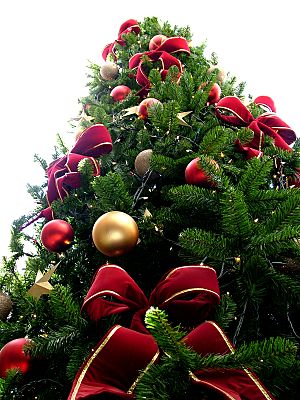Yule facts for kids
Yule (also called Jul, jól or joulu) is a festival historically observed by the Germanic peoples. Scholars have connected the original celebrations of Yule to the Wild Hunt, the god Odin, and the pagan Anglo-Saxon Mōdraniht ("Mothers' Night").
During Christianisation, Yule was reformulated, whereupon the term Christmastide came to predominate in English. Some present-day Christmas customs and traditions such as the Yule log, Yule goat, Yule boar, Yule singing, and others may have connections to older pagan Yule traditions. Cognates to Yule are still used in English, the Scandinavian languages as well as in Finnish and Estonian to describe Christmas and other festivals occurring during the winter holiday season.
Etymology
Yule is the modern version of Old Norse Jól and Jólnir one of the names for Odin. The Old English derivates ġēol or ġēohol and ġēola or ġēoli, indicates the 12-day festival of "Yule" (later: "Christmastide") and the latter indicating the month of "Yule", whereby ǣrra ġēola referred to the period before the Yule festival (December) and æftera ġēola referred to the period after Yule (January). Both words are cognate with Gothic 𐌾𐌹𐌿𐌻𐌴𐌹𐍃 (jiuleis); Old Norse, Icelandic, Faroese and Norwegian Nynorsk jól, jol, ýlir; Danish, Swedish, and Norwegian Bokmål jul, and are thought to be derived from Proto-Germanic *jehwlą-. The etymological pedigree of the word remains uncertain, though numerous speculative attempts have been made to find Indo-European cognates outside the Germanic group, too. The noun Yuletide is first attested from around 1475.
The word is conjectured in an explicitly pre-Christian context primarily in Old Norse. Among many others (see List of names of Odin), the long-bearded god Odin bears the name Jólnir ('the Yule one'). In Ágrip, written in the 12th century, Christmas, jól is interpreted as coming from one of Odin's names, Jólni(r). In poetic language, a plural form (Old Norse jóln) may also refer to the gods collectively. In Old Norse poetry, the word is found as a term for 'feast', e.g. hugins jól (→ 'a raven's feast').
Germanic paganism
Yule is an indigenous winter festival celebrated by the Germanic peoples. The earliest references to it are in the form of month names, where the Yule-tide period lasts somewhere around two months, falling along the end of the modern calendar year between what is now mid-November and early January.
Attestations
Yule is attested early in the history of the Germanic peoples; in a Gothic language calendar of the 5–6th century it appears in the month name fruma jiuleis, and, in the 8th century, the English historian Bede wrote that the Anglo-Saxon calendar included the months geola or giuli corresponding to either modern December or December and January.
While the Old Norse month name ýlir is similarly attested, the Old Norse corpus also contains numerous references to an event by the Old Norse form of the name, jól. In chapter 55 of the Prose Edda book Skáldskaparmál, different names for the gods are given; one is "Yule-beings". A work by the skald Eyvindr skáldaspillir that uses the term is then quoted: "again we have produced Yule-being's feast [mead of poetry], our rulers' eulogy, like a bridge of masonry". In addition, one of the numerous names of Odin is Jólnir, referring to the event.
The Saga of Hákon the Good credits King Haakon I of Norway who ruled from 934 to 961 with the Christianization of Norway as well as rescheduling Yule to coincide with Christian celebrations held at the time. The saga says that when Haakon arrived in Norway he was a confirmed Christian, but since the land was still altogether heathen and the people retained their pagan practices, Haakon hid his Christianity to receive the help of the "great chieftains". In time, Haakon had a law passed establishing that Yule celebrations were to take place at the same time as the Christians celebrated Christmas, "and at that time everyone was to have ale for the celebration with a measure of grain, or else pay fines, and had to keep the holiday while the ale lasted."
Yule had previously been celebrated for three nights from midwinter night, according to the saga. Haakon planned that when he had solidly established himself and held power over the whole country, he would then "have the gospel preached". According to the saga, the result was that his popularity caused many to allow themselves to be baptized, and some people stopped making sacrifices. Haakon spent most of this time in Trondheim. When Haakon believed that he wielded enough power, he requested a bishop and other priests from England, and they came to Norway. On their arrival, "Haakon made it known that he would have the gospel preached in the whole country." The saga continues, describing the different reactions of various regional things.
Contemporary traditions
In modern Germanic language-speaking areas and some other Northern European countries, yule and its cognates denote the Christmas holiday season. In addition to yule and yuletide in English, examples include jul in Sweden, Denmark, and Norway, jól in Iceland and the Faroe Islands, joulu in Finland, Joelfest in Friesland, Joelfeest in the Netherlands and jõulud in Estonia.
Modern paganism
As contemporary pagan religions differ in both origin and practice, these representations of Yule can vary considerably despite the shared name. Some Heathens, for example, celebrate in a way as close as possible to how they believe ancient Germanic pagans observed the tradition, while others observe the holiday with rituals "assembled from different sources." Heathen celebrations of Yule can also include sharing a meal and gift giving.
In most forms of Wicca, this holiday is celebrated at the winter solstice as the rebirth of the Great horned hunter god, who is viewed as the newborn solstice sun. The method of gathering for this sabbat varies by practitioner. Some have private ceremonies at home, while others do so with their covens.
See also
 In Spanish: Yule para niños
In Spanish: Yule para niños



